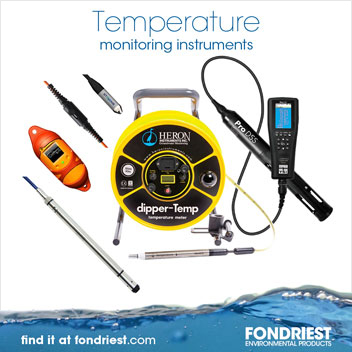Temperature Profiling in Lakes
Why Monitoring Matters
Many lakes greater than 12 feet in depth will stratify, forming layers of water with different temperature. This thermal stratification occurs due to differences in density between warm and cold waters, with cold water being denser and less viscous than warm water. Limnologists categorize the resulting layers from top to bottom — and therefore warmest to coolest — as the epilimnion, the thermocline and the hypolimnion. During the winter, however, lakes undergo inverse stratification, with ice forming above the coolest layer of liquid water, and the warmer layer resting on the bottom. In early spring, the lake “turns over,” reverting to its standard thermal stratification.
Monitoring the yearly evolution of thermal stratification is a critical component in lake management and research, as the phenomenon can impact many aspects of the lake, including spatial distribution of fish, microbial growth and oxygen content. In many lakes in the summer, tiny invertebrates and microorganisms consume dead algae and zooplankton. The decomposition process uses oxygen. Because lakes do not mix in the summer, the hypolimnion does not receive fresh oxygen, making it possible for anoxic zones to form during this time.
Lake management guidelines vary from state to state, so there is no standard requirement for temperature profiling. However, there are common configurations for lake temperature monitoring systems based on the size and volume of the lake. A buoy-based real-time monitoring solution can enable lake managers and researchers to respond to unusual or troubling temperature readings.
Lake Management
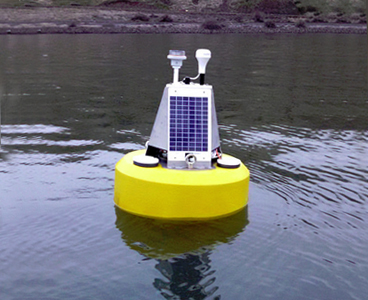 “Lake management” is a broad term that can incorporate many disciplines and applications. Management of a single lake can include conservation, improvement, restoration and rehabilitation projects, as well as studies of the local watershed and other bodies of water in the system.
“Lake management” is a broad term that can incorporate many disciplines and applications. Management of a single lake can include conservation, improvement, restoration and rehabilitation projects, as well as studies of the local watershed and other bodies of water in the system.
The North American Lake Management Society recommends “iterative steps” when managing lakes and watersheds. Small efforts toward an established goal cost less than major improvements, and are less likely to negatively impact non-targeted organisms and other aspects of the lake. It warns, however, that certain techniques are only effective when performed at a larger scale, potentially raising the cost and impact of lake management. Compromises may be necessary to achieve a desired effect under constrictions of time and funding, but local regulations should be consulted to determine whether any action to a lake or watershed is appropriately justified.
There are a variety of approaches to lake management, and many techniques capable of altering a lake’s nutrient content, oxygen levels, biotic distributions and sediment composition. These can be as “simple” as harvesting plants, adding bacteria and removing certain fish species, or can include more complicated measures, such as lowering water levels, dredging sediment or controlling various hydraulic factors. Any of these operations can interfere with a lake’s thermal profile, so it is advisable to maintain a temperature monitoring system before, during and after a project.
Impacts of Lake Temperature
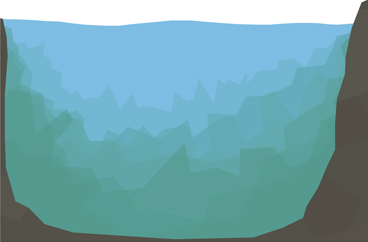
Temperature has a significant impact on water chemistry, and a number of phenomena can occur when a lake’s water temperature and chemical properties reach certain thresholds. Not all of these phenomena are necessarily negative; many are naturally occurring (as in without anthropogenic influence) and some are unavoidable. But the implementation of a real-time temperature profiling system can enable lake managers to respond to troubling signs in advance.
Learn more in the Water Temperature section.
A Real-Time Solution
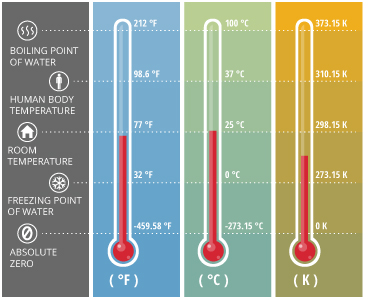 Lake temperature can be accurately measured in real time or at scheduled intervals. The addition of data logging and telemetry instruments enables researchers and managers to study temperature readings remotely at their convenience. To ensure that temperature is being measured throughout a lake’s stratified layers, thermistor strings should be used, rather than individually mounted temperature sensors.
Lake temperature can be accurately measured in real time or at scheduled intervals. The addition of data logging and telemetry instruments enables researchers and managers to study temperature readings remotely at their convenience. To ensure that temperature is being measured throughout a lake’s stratified layers, thermistor strings should be used, rather than individually mounted temperature sensors.
Learn more in the Water Temperature section.
Typical Temperature Profiling System
The system used to monitor temperature stratification in a lake will vary based on its depth, width and other hydrological properties. Man-made features such as dams can also influence lake stratification, and therefore require special considerations for size and placement of a monitoring system.
To be effective, measurement data should be provided in real time. The easiest and most efficient way to do this is with a buoy-based temperature monitoring system. A data buoy can house sensors at multiple depths within the water column. This system can then securely transmit the data to the Internet in real time for access from any computer or mobile device.
Buoy systems are flexible and customizable based on the lake’s requirements .A single buoy suspending a string of four thermistors may be suitable for smaller lakes, while larger lakes or lakes with multiple inputs and outputs might necessitate multiple buoys at different points.
A suitable data buoy can house as many sensors as needed, and all equipment is powered via a marine battery and recharging solar panel system. With multiple telemetry options to choose from, continuous real-time data are always available. This ensures that lake managers and researchers can respond to unusual temperature readings at a moment’s notice.
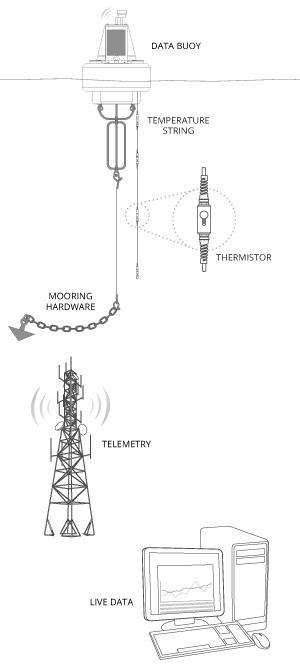
Data Buoy
A data buoy is a floating platform that supports real-time monitoring instruments such as sensors and data loggers. In addition to housing the monitoring equipment, the buoy supplies all power and can transmit sensor data in real time.
Thermistor String
A thermistor string can also be referred to as a thermistor chain, temperature string, or temperature chain. Regardless of the nomenclature, it can be defined as a series of thermistors or temperature elements embedded along a single cable assembly.
Thermistor
Each temperature node consists of a titanium thermistor and circuit board housed in a waterproof body. Measured data is converted into a digital signal and transmitted through the string.
Telemetry
Telemetry provides temperature monitoring data in real time by sending the data to a central computer or web-based datacenter. The wireless communication can be radio-to-shore, cellular or satellite based.
Live Data
Temperature data can be viewed instantly at any time 24/7 through an online datacenter. This data can be viewed in real time, or as a graph to see trends. Automated alerts can be sent in real time via text or email when temperature exceeds or falls below pre-defined thresholds.
Monitoring Location
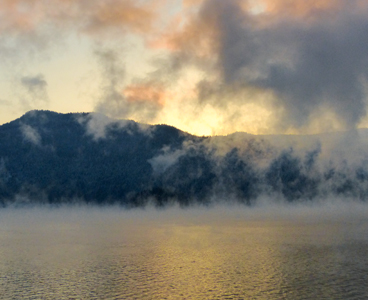 Where a temperature profiling monitoring system should be located will depend largely on the site conditions of the lake. Careful planning is needed to select the location, determine depth and water level fluctuation, and design a mooring solution that will effectively hold the system in place without damaging the instruments.
Where a temperature profiling monitoring system should be located will depend largely on the site conditions of the lake. Careful planning is needed to select the location, determine depth and water level fluctuation, and design a mooring solution that will effectively hold the system in place without damaging the instruments.
Selecting the Location
As suggested by the name, stationary systems are set at fixed locations. These systems can be placed on structure or on an anchored buoy in the water. However, site conditions often make it difficult or impractical to mount the monitoring equipment along the shore. In addition, relying solely on shoreline solutions may not accurately represent thermal stratification. For these reasons, buoy-based systems offer the most comprehensive and cost-effective solution. Data buoys provide a stable platform for temperature profiling, with the ability to house multiple sensors at different depths in the water column. In addition, they can carry a data logger, solar-powered battery pack, and telemetry (wireless communications) systems for extended deployments.
These buoys can come in different sizes based on the environmental conditions and the number of sensors suspended from the buoy. Data buoys with 150- to 450-lb. net buoyancy are generally adequate for monitoring projects on rivers, inland lakes and protected waters. Larger platforms may be required in coastal and Great Lakes deployments that are subject to more extreme conditions and wave action.
Pre-Deployment
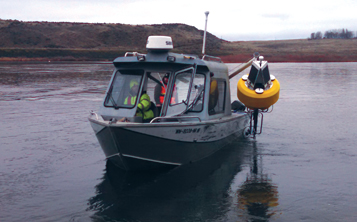 For accurate data, all sensors should be calibrated shortly before the project begins. If using a buoy-based system, the platforms should be fully assembled on shore prior to deployment. This includes attaching any sensors, towers, solar panels and additional ballast weights if needed. Furthermore, the complete turbidity monitoring system (sensors, data logger, telemetry, software) should be tested before the buoy is put in the water. While this process ensures that all equipment is functioning within specifications, it also gives everyone the chance to familiarize themselves with the system prior to deployment. Issues are always easier to deal with before the buoy platform is deployed in the water.
For accurate data, all sensors should be calibrated shortly before the project begins. If using a buoy-based system, the platforms should be fully assembled on shore prior to deployment. This includes attaching any sensors, towers, solar panels and additional ballast weights if needed. Furthermore, the complete turbidity monitoring system (sensors, data logger, telemetry, software) should be tested before the buoy is put in the water. While this process ensures that all equipment is functioning within specifications, it also gives everyone the chance to familiarize themselves with the system prior to deployment. Issues are always easier to deal with before the buoy platform is deployed in the water.
Buoy Mooring
A buoy-based system must be moored to ensure that it remains stationary. It is recommended to moor the buoy in the deepest part of the waterway to ensure the most inclusive measurements. This allows for multiple measurement depths and will best reflect the characteristics of the water body as a whole. Buoy-based systems are typically moored as either a single-point or two-point mooring, based on environmental and application-specific factors.
Learn more in the Buoy Mooring section.
Data Management
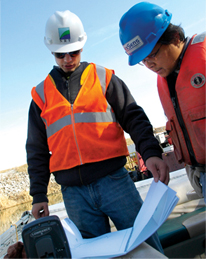 A major part of any monitoring project is collecting and accessing the data. While it is possible to simply record measurements onsite, the ability to log, send and view monitoring data in real time is far more efficient.
A major part of any monitoring project is collecting and accessing the data. While it is possible to simply record measurements onsite, the ability to log, send and view monitoring data in real time is far more efficient.
Learn more in the Monitoring Equipment section.
Quality Assurance
Accurate data help lake managers remain in compliance with set regulations, respond to potential quality concerns and adjust treatment regimes. The same standard of accuracy ensures that researchers are able to conduct valid analyses and draw useful conclusions.
Thermistors are very sensitive to temperature changes, and in regular use conditions, will rarely require calibration. However, they exhibit an aggressively nonlinear characteristic, that is, the relationship between electrical resistance and temperature. Generally, this will manifest in the form of reduced measurement resolution only at very high temperatures. Manufacturers may provide curve forms to help users compensate, or users can calibrate their own response curves with the help of an accurate temperature measurement standard.
System Maintenance
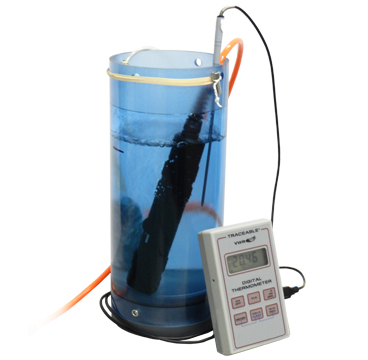 Regardless of the temperature profiling equipment chosen to monitor a lake, periodic maintenance and calibration is required. Instrument maintenance includes cleaning the thermistors and replacing any deteriorating o-rings to prevent water ingress. If using additional water quality sensors, further field servicing may be required. Maintenance intervals are largely dependent on site conditions and other variables, such as the potential for biofouling. A system where the only deployed instrument is a thermistor string can likely go a full season without any maintenance requirements.
Regardless of the temperature profiling equipment chosen to monitor a lake, periodic maintenance and calibration is required. Instrument maintenance includes cleaning the thermistors and replacing any deteriorating o-rings to prevent water ingress. If using additional water quality sensors, further field servicing may be required. Maintenance intervals are largely dependent on site conditions and other variables, such as the potential for biofouling. A system where the only deployed instrument is a thermistor string can likely go a full season without any maintenance requirements.
In case of sensor failure or damage, it is useful to have spare sensors or thermistor strings on hand. These can be field swapped during routine maintenance checks. Having a spare thermistor string available will reduce downtime due to unforeseen sensor failure, which could cause critical and costly interruptions to a temperature profiling system.
For greater details regarding maintenance requirements and sensor calibration, the manufacturer’s user manual should be referenced.
Performance Verification
Thermistors cannot be calibrated by the user, but they should be checked periodically against a precision thermistor to ensure readings are still within specification. Given the number of thermistors on a string, it is generally recommended to send the string back to the factory for a performance check. This can be done on an annual or bi-annual basis.
Recommended Equipment
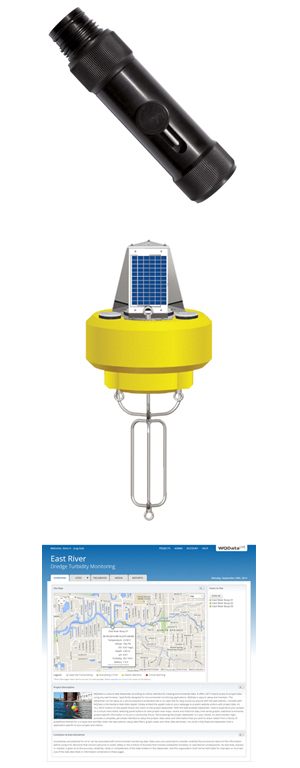 While there are plenty of thermistors and temperature monitoring instruments on the market, some stand out about the rest. Fondriest Environmental has selected these products as the best in their field for their quality, reliability and value. Together, they provide an advanced and powerful real-time temperature profiling system. The NexSens T-Node FR temperature sensors can be connected in-series and suspended vertically from a data buoy to create a highly accurate, multi-point thermistor string. The rugged NexSens CB-450 offers long-term durablity with 30 watts of solar power, 450 pounds of buoyancy and a choice of instrument mounts for multiple sensors. Additionally, the WQData Live web datacenter allows 24/7 remote access to collected data from any computer or mobile device, while incorporating instant alarm notifications and trend tracking.
While there are plenty of thermistors and temperature monitoring instruments on the market, some stand out about the rest. Fondriest Environmental has selected these products as the best in their field for their quality, reliability and value. Together, they provide an advanced and powerful real-time temperature profiling system. The NexSens T-Node FR temperature sensors can be connected in-series and suspended vertically from a data buoy to create a highly accurate, multi-point thermistor string. The rugged NexSens CB-450 offers long-term durablity with 30 watts of solar power, 450 pounds of buoyancy and a choice of instrument mounts for multiple sensors. Additionally, the WQData Live web datacenter allows 24/7 remote access to collected data from any computer or mobile device, while incorporating instant alarm notifications and trend tracking.
Learn more about these products
Cite This Work
Fondriest Environmental, Inc. “Temperature Profiling in Lakes.” Fundamentals of Environmental Measurements. 3 Mar. 2014. Web. < https://www.fondriest.com/environmental-measurements/environmental-monitoring-applications/temperature-profiling-in-lakes/ >.


